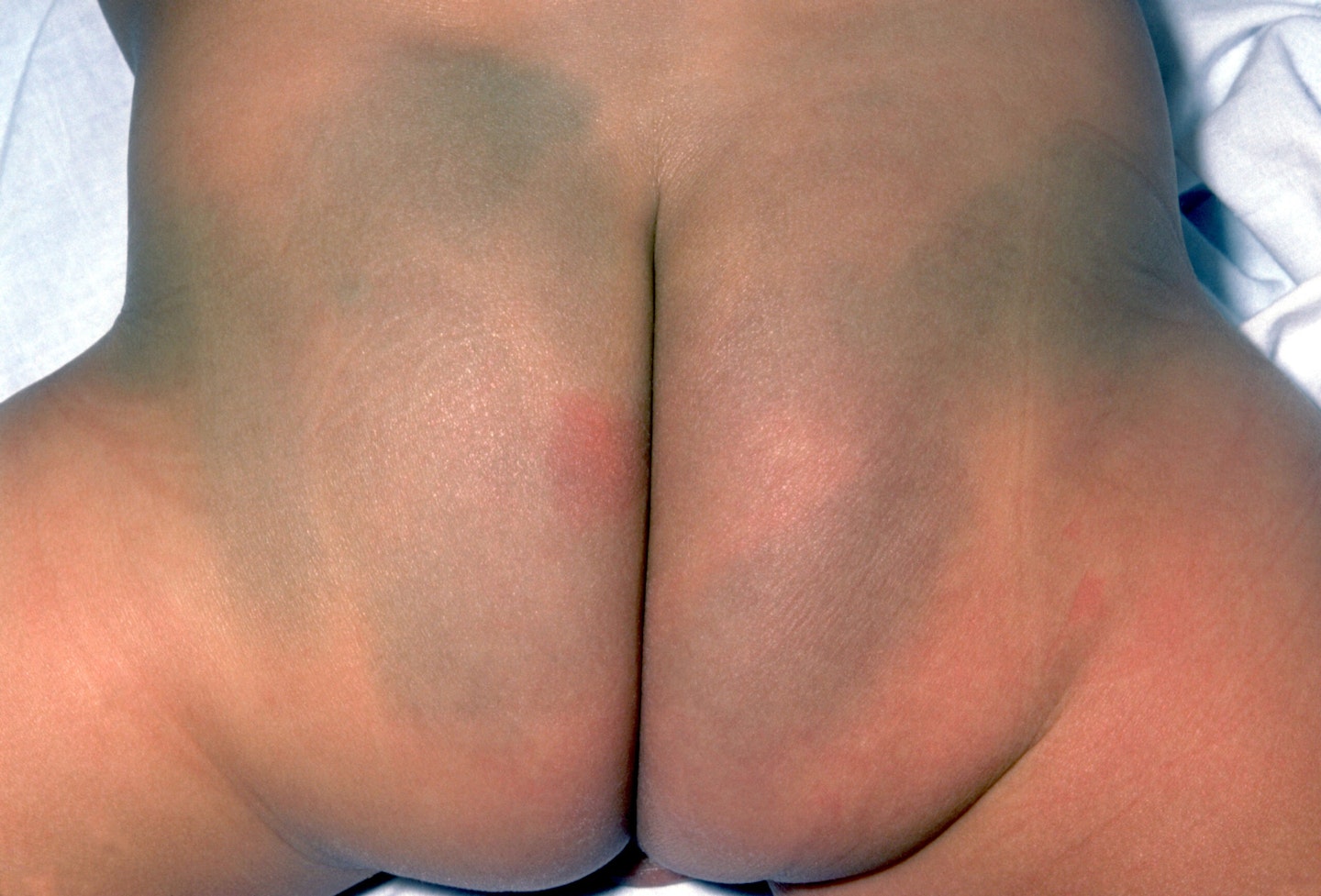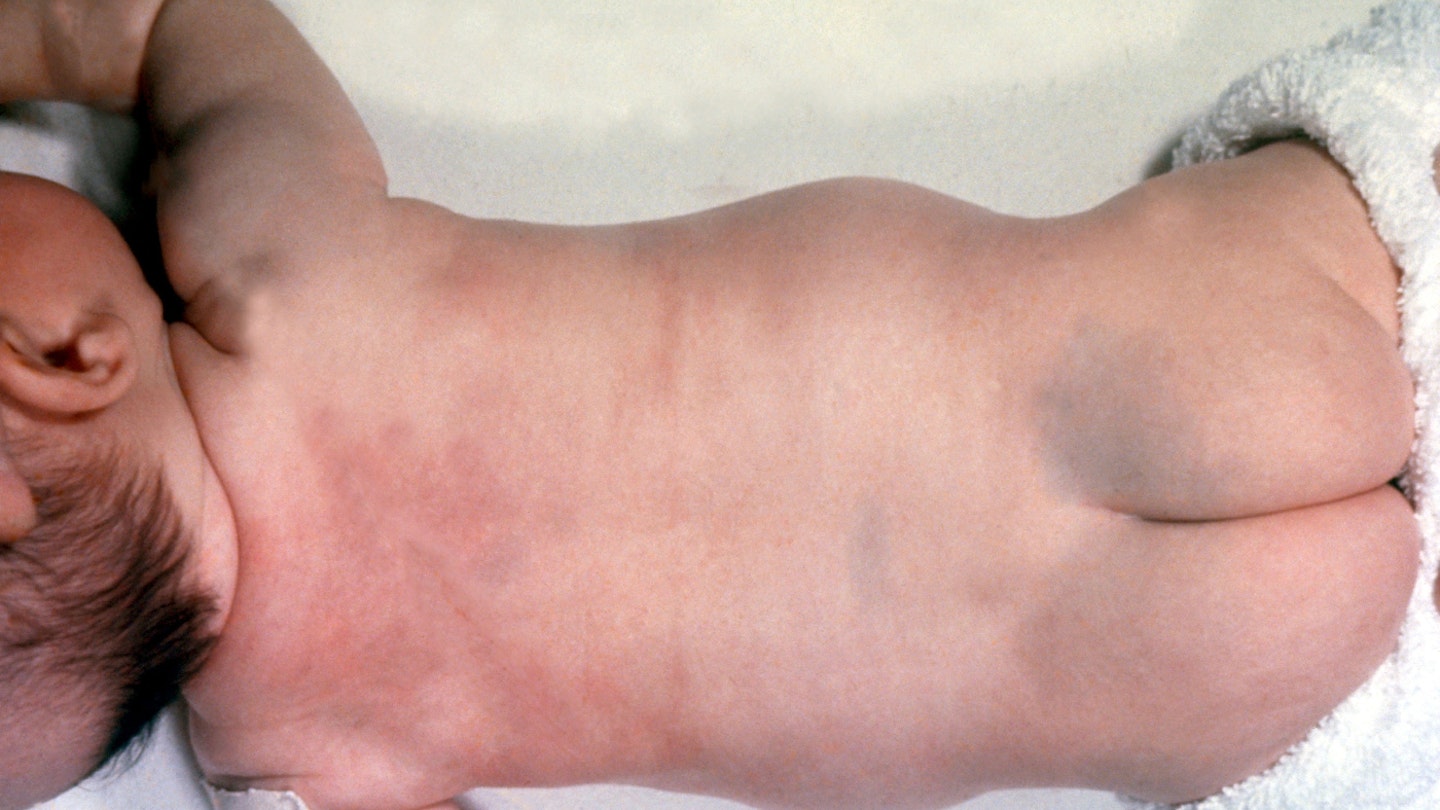If you notice your baby has blueish-grey marks on their buttocks and back, they may have what’s called blue-grey spots or slate grey nevus, a type of birthmark. They were known for many years as Mongolian blue spots but this term is no longer considered to be appropriate and it’s known in the medical world as Congenital dermal melanocytosis.
It’s easy for a parent to be alarmed when noticing blue-grey spots (just like with strawberry birthmarks). You may even mistake them for bruises but, to a train eye, these spots can be identified correctly and quickly. The baby should be examined thoroughly to rule out any other disorders of the skin before making a diagnosis of blue-grey spots.
Do blue-grey spots require treatment?
Blue-grey spots can appear as one large patch across a baby’s skin or several smaller spots. They have no particular shape to them and can look almost like paint has been flicked up the baby’s back. They are flat and cause the baby no problems, so no treatment is necessary. Parents should avoid using creams or medications in the hope of reducing the appearance of these spots as it’s likely not to work and may cause more harm than good.
Where do blue-grey spots appear?

Blue-grey spots commonly occur on the buttocks and back but can actually appear anywhere. Many babies will have them on their legs, shoulders, arms and sometimes face. In terms of size, some spots can be as small as a few millimetres whilst others can be up to 10 centimetres or more.
These marks can be found in all children but are more commonly seen in children of African or South Asian descent and those with darker skin. In fact, 80 to 90 per cent of babies of African and South Asian descent will have a blue-grey spot somewhere on their body. The incidence of blue-grey spots in fair skinned infants is approximately 10 per cent.
Blue grey spots don’t discriminate when it comes to the sex of the baby. They are present in both males and females, however some studies have suggested that there is a slightly higher incidence of them amongst male infants.
Why causes blue-grey spots?
Blue-grey spots are thought to occur during pregnancy as the fetus is developing. Cells in the skin that produce and contain the pigment called melanin are called melanocytes. Melanocytes are present in the dermis (middle layer of skin) of an embryo by as early as ten weeks gestation. These melanocytes move to the epidermis (top layer of skin) by around 11 to 14 weeks gestation. There shouldn’t be any melanocytes left in the dermal layer of skin by 20 weeks so in the instance of blue-grey spots, for reasons unknown, the melanocytes remain in the dermis and actively produce melanin, resulting in areas of darker pigment.
Some parents wonder if the marks will ever go but, in most cases, these marks will fade by the time a child is six years old. Some people, however, will have them for much longer.
Rarely, blue-grey spots persist in to adulthood. For many people, they are not bothered by them. For others, they may feel self conscious, particularly if the blue-grey spots are covering large areas. Nowadays there is treatment available for those wanting to reduce the appearance of these types of pigmentation marks. Laser treatment is a popular option but is not effective for everyone.
What should I do if I notice a blue-grey spot on my baby?
If a blue-grey spot is noticed at birth then it should be documented by the person examining your newborn so that they are not mistaken for bruises. If it’s not documented and you notice it, ensure a health professional notes it down in the red book. There will be plenty of opportunity for this to happen as you should see numerous health professionals within the days and weeks after your baby’s birth. Although initially blue-grey spots may be mistaken for bruises, its important to note that true bruises quickly change in colour and size within a few days, whereas blue-grey spots remain the same.
Marley Hall aka @midwifemarley is a registered midwife who lives with her partner and five children (including a set of twins) in Surrey. She has practiced midwifery for more than a decade in both the NHS and the private sector, and is an expert in all things antenatal, pregnancy and postnatal care for women. Marley’s passion for education and informed consent shines in everything she does. She is a founder of @ChildBirthDownloads and is teaching parents about all aspects of mainly pregnancy stories, from birth plans to c-section scar advice.
_Her latest book, The modern bible for pregnancy, birth and the fourth trimester::a[Midwife Marley’s Guide for Everyone]{href='https://amzn.to/39y2yCV' target='blank' rel='noreferrer noopener'}, was released in March 2022.
